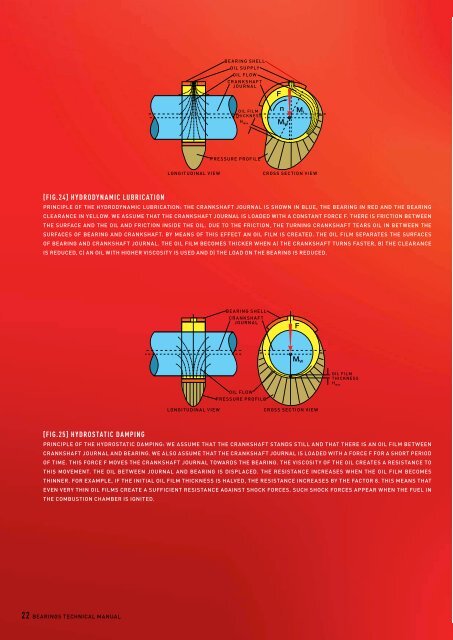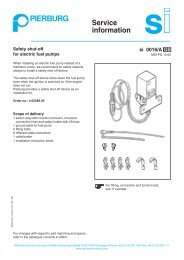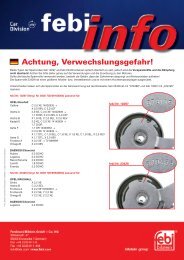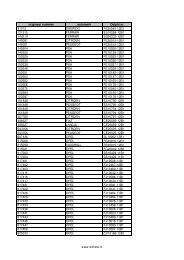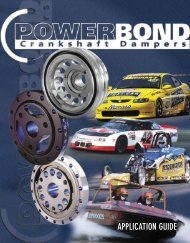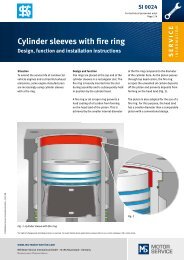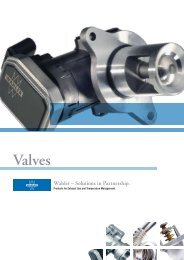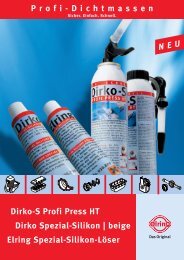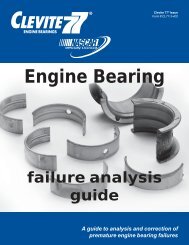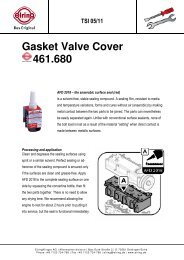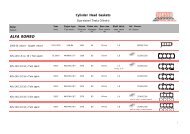EvEry bEaring you nEEd
EvEry bEaring you nEEd
EvEry bEaring you nEEd
You also want an ePaper? Increase the reach of your titles
YUMPU automatically turns print PDFs into web optimized ePapers that Google loves.
[fig.24] Hydrodynamic lubrication<br />
longitudinal view<br />
bearing shell<br />
oil supply<br />
oil flow<br />
crankshaft<br />
journal<br />
oil film<br />
thickness<br />
h min<br />
pressure profile<br />
bearing shell<br />
crankshaft<br />
journal<br />
F<br />
n<br />
M W<br />
M L<br />
cross section view<br />
principle of the hydrodynamic lubrication: the crankshaft journal is shown in blue, the bearing in red and the bearing<br />
clearance in yellow. We assume that the crankshaft journal is loaded with a constant force f. There is friction between<br />
the surface and the oil and friction inside the oil. Due to the friction, the turning crankshaft tears oil in between the<br />
surfaces of bearing and crankshaft. By means of this effect an oil film is created. The oil film separates the surfaces<br />
of bearing and crankshaft journal. The oil film becomes thicker when a) the crankshaft turns faster, b) the clearance<br />
is reduced, c) an oil with higher viscosity is used and d) the load on the bearing is reduced.<br />
F<br />
The physics of lubrication<br />
One of the oil film’s functions is to separate the bearings from the<br />
crank pins. When discussing lubrication we distinguish between<br />
two physical effects: hydrodynamic lubrication, which is caused<br />
by rotation and hydrostatic damping, which cushions shock load.<br />
In an internal combustion engine the two effects overlap.<br />
Hydronamic lubrication<br />
Figure 24 explains the principle of hydrodynamic lubrication. A<br />
shaft on which a force is acting is rotating in its bearing. The bearing<br />
is supplied with oil from above via the oil borings. Through<br />
friction the shaft draws oil through the lubrication gap and creates<br />
the oil film. The oil film produces an even distribution of<br />
pressure that separates the shaft from the bearing. However, the<br />
oil is not only drawn through the lubrication gap but also flows<br />
laterally out of the bearing.<br />
Hydrostatic damping<br />
The principle of hydrostatic damping is illustrated in Figure 25. In<br />
the case shown, the shaft and pins are separated from each other<br />
by the oil film. A periodic load is suddenly imposed from above,<br />
for instance via the ignition of the combustion of the fuel-air mix<br />
in the combustion chamber. This periodic force displaces the oil,<br />
driving it in all directions out of the lubrication gap between shaft<br />
and bearing. The greater the oil’s viscosity, the greater the resistance<br />
to this displacement process, and resistance to it increases<br />
greatly as the thickness of the lubricant film decreases. The oil’s<br />
resistance to displacement thus prevents the shaft and bearing<br />
from coming into contact during the imposition of a periodic load<br />
of brief duration.<br />
[fig.26]<br />
Combustion and inertia forces move the crankshaft journal<br />
inside the bearing. The illustration shows a typical journal<br />
orbit of a crankshaft journal in a con rod bearing (bearingfixed<br />
view). The distance between the surfaces of bearing and<br />
crankshaft journal is indicated as ∑ at ∑ = 0, the crankshaft<br />
journal is in the middle of the bearing, at ∑ = 1, crankshaft<br />
journal and bearing touch each other. As can be seen, the<br />
smallest distances appear in the upper shell of the bearing<br />
for a relatively long way of the journal orbit. This explains<br />
why the wear is higher in the upper shell than in the lower<br />
shell of a con rod bearing.<br />
[fig.25] Hydrostatic damping<br />
longitudinal view<br />
oil flow<br />
pressure profile<br />
M W<br />
cross section view<br />
oil film<br />
thickness<br />
H min<br />
principle of the hydrostatic damping: we assume that the crankshaft stands still and that there is an oil film between<br />
crankshaft journal and bearing. We also assume that the crankshaft journal is loaded with a force f for a short period<br />
of time. This force f moves the crankshaft journal towards the bearing. The viscosity of the oil creates a resistance to<br />
this movement. The oil between journal and bearing is displaced. The resistance increases when the oil film becomes<br />
thinner. For example, if the initial oil film thickness is halved, the resistance increases by the factor 8. This means that<br />
even very thin oil films create a sufficient resistance against shock forces. Such shock forces appear when the fuel in<br />
the combustion chamber is ignited.<br />
Both combustion forces and inertial forces are acting on the<br />
shaft. These forces ensure that the crank pins describe a complex<br />
displacement path within the bearing (Figure 26). The minimum<br />
lubrication film thickness, i.e., the smallest gap between crank pins<br />
and bearings, occurs during the combustion process. Calculations<br />
have shown that this gap can be less than one micrometer.<br />
Efficiency of Filter (%)<br />
Particle Size (µm)<br />
Dirt problems<br />
The effectiveness of a typical paper oil filter is charted in Figure<br />
27. Contaminant particles with diameters greater than 25 μm will<br />
be filtered out of the oil with a high probability of passing the<br />
oil filter once. However, the smaller the contaminant particle, the<br />
lower the probability that it will be intercepted by the oil filter,<br />
and in our example a particle 5 μm in diameter will only be intercepted<br />
in a relatively low number of all cases.<br />
Thus most of the smallest contaminant particles will not be stopped<br />
by the oil filter. However, they are capable of damaging bearings<br />
and crank pins. This consideration makes clear the importance of<br />
ensuring absolute cleanliness when overhauling an engine.<br />
[fig.27]<br />
Efficiency of a typical paper oil filter depending<br />
of the size of the dirt particles in the oil when<br />
the oil passes the filter once.<br />
22 Bearings Technical Manual<br />
23


